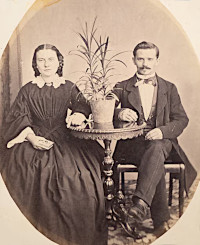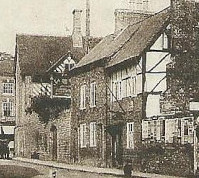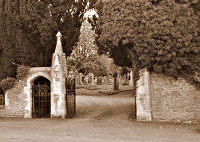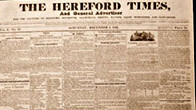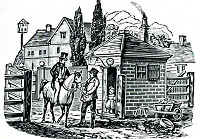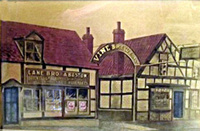Ledbury has a fascinating history and there are excellent websites and books recording life in this small market town.
Often restricted by time and space a broad sweep of the subject is sometimes adopted but there is still
much to be discovered. The nineteenth century seems to be relatively unexplored, which is a pity as
it was a time of great change. This web site looks in detail at some little known facts.
Click the image in any section for the full story.
Scroll down for more.
Families.
Here you will find stories of interesting local people.
The Mutlow and Russell sections contain a lot of local history.
Bye Street.
North side.
Bye Street today is uninteresting when compared with the warren of tenements, shops and businesses of the C19 and early C20 and I have explored its history here. An early description by George Wargent (1824 ─ 1909)
seen here.should be read first.
Bye Street.
South side.
This page explores the South side of Bye Street and includes the Cattle Market.
New Street.
North side.
New Street has not changed much over the years. This page explores the North side from the Bell Inn to the old Ring of Bells pub. The Ledbury Mineral Water Works is of particular interest based as it was in what is now the Barn House.
New Street.
South side.
Here the South side of New Street is explored from the Top Cross to Linden House.
The Talbot Inn and the Vine Tap Inn area is of particular interest and the origins of the Ledbury Advertiser in Glenmoir is shown.
The Southend.
The Southend street in the nineteenth and early twentieth century provided almost any service you could wish for -
boots fixed, hair done, grocery, meat, greengrocery, drapery and legal affairs sorted out.
Today few of these facilities remain.
Look at the history of the street by clicking on the picture and take a walk down from the Upper Cross.
The Iron Church in New Street.
The Rev. John Jackson arrived in Ledbury in 1860 and upset many of his parishioners so much that they deserted the established church
and set up an independent one in a tin church in New Street.
You can read the full story in this section.
The Cemetery.
A town's history lies in its churchyard. Ledbury is no exception.
Here you will find a history of the cemetery and
a list of Monumental Inscriptions for Conformists and Non Conformists up to 1900.
The Canal.
The arrival of the Gloucester to Hereford canal and later the railway is a good example of how an integral
part of a town’s history can be almost overlooked yet it altered the face and the fortunes of Ledbury.
Along the Towpath.
The first part in this section looks at the history of the canal.
This section takes you on a walk from the Old Wharf to the bridge, which still exists, under the Malvern to
Hereford railway and showing features along the route.
Canal Cuttings.
Giving a flavour of life on the canal these Newspaper cuttings give some
idea of what boatmen and wharfmen got up to.
Policing Ledbury.
Canal trade opened up communication and the population grew. More trade attracted undesirables and the need
for an effective police force became essential.
How was Ledbury policed during the nineteenth century? Click on the policemen to find out.
Lock Ups.
A Police Force needs Police Stations and Lock Ups.
This section is about the early police station in New Street and the Lock Up in Church Street, shown above.
The Post Office.
The history of the Ledbury Post Office with its various locations is shown here from 1841 to the present day including the Homend and New Town Sub Offices.
Ledbury Toll Houses.
The Toll Road system and the houses associated with it are discussed here. Relevant research and newspaper reports of the nineteenth century
give some idea of the life and times of the gatekeepers.
The First Coffee Shop.
Today there are at least a dozen places in Ledbury where you can satisfy your coffee craving but in 1880 there was just one
Grab the cup and read all about it.
The Butcher Row Museum.
The Butcher Row museum in Church Lane has an interesting history.
An Act of Parliament was needed to secure the building's removal from the row of
buildings causing obstruction in the middle of the High Street.
The Trehernes of Ledbury.
Something a bit different here. A story of mischief and drunkenness on the canal between Gloucester and Ledbury followed by a history of the Trehernes.
Lane Bros. & Bastow..
The Vine Brewery in New Street was owned by Lane Bros. and Bastow from 1873 to 1918.
John Lane's story is almost unbelievable and Charles Bastow's rather sad.
You can read the full story in this section.
I am indebted to all members of the Old Ledbury Facebook Group for their collective memories without which the research for this site would have been even more difficult.
Comments and help with research always appreciated.

